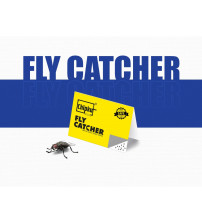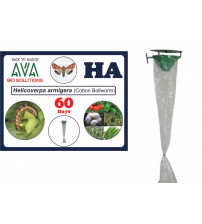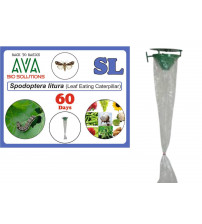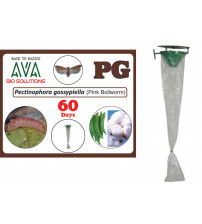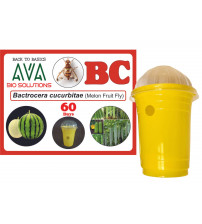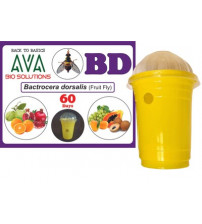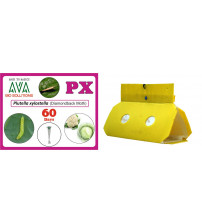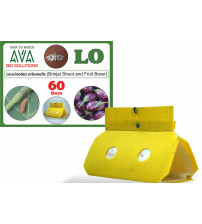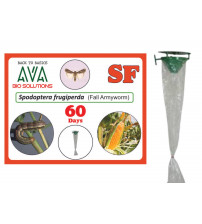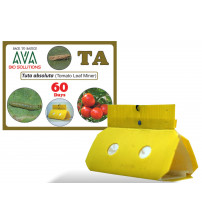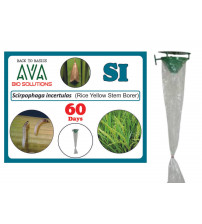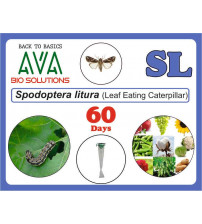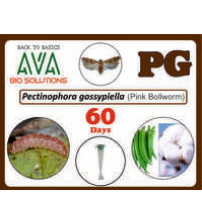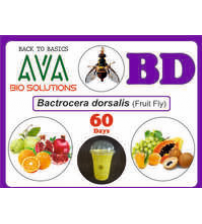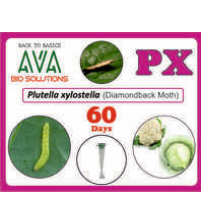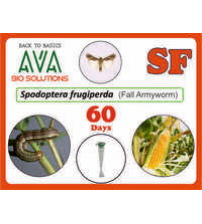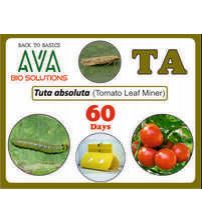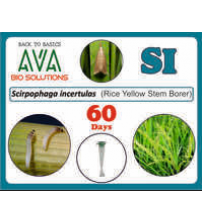Shopping Cart
0 item(s) - Rs 0.00Ava Helicoverpa Armigera (HA) Lure
Brand: Ava Bio Solutions
Categories: Insects Traps, Pheromone Lures & Traps,
Availability: In Stock
Cash on delivery Availability: NO
Ava Helicoverpa Armigera (HA) Lure of Cotton Bollworm
Description:
Pheromone Lure of Cotton Bollworm (Helicoverpa Armigera)
Target Crops: Cotton, Pomegranate, Tur, Gram, Tomato, Capsicum, Grapes, Rose, Sunflower, Safflower, Potato, Caster, Maize, Sorghum, Peas etc.
Trap to be used: Funnel Trap
Number of traps per Acre: 7 - 8
Life of Lure: 60 Days
Cotton Bollworm (Helicoverpa armigera)
Identification:
The cotton bollworm is variable in both size and color. The body length varies between 12 millimeters (0.47 in) and 20 millimeters (0.79 in) with a wingspan of 30–40 millimeters (1.2–1.6 in). The forewings are yellowish to orange in females and greenish-gray in males, with a slightly darker transversal band in the distal third. The external transversal and sub-marginal lines and the reniform spot are diffused. The hind wings are a pale yellow with a narrow brown band at the external edge and a dark round spot in the middle.
Life Cycle:
The female cotton bollworm can lay several hundred eggs, distributed on various parts of the plant. Under favorable conditions, the eggs can hatch into larvae within three days and the whole life cycle can be completed in just over a month. The eggs are spherical, 0.4 to 0.6 mm in diameter, and have a costate surface. They are white, later becoming greenish.
The larva takes 13 to 22 days to develop, reaching up to 40 mm in length in the sixth instar. Their coloring is variable but mostly greenish and yellow to red-brown. The head is yellow with several spots. Three dark stripes extend along the dorsal side and one yellow light stripe is situated under the spiracles on the lateral side. The ventral parts of the larvae are pale. They are rather aggressive, occasionally carnivorous, and may even cannibalise each other. If disturbed, they fall from the plant and curl up on the ground. The pupae develop inside a silken cocoon over 10 to 15 days in the soil at a depth of 4–10 centimeters (1.6–3.9 in), or in cotton bolls or maize ears.
Adult moth wingspan is 30-45 mm. The forewings are brownish or reddish-brown (females) or dull greenish to yellow or light brown (males). Hind wings are pale with a broad, dark outer margin. H. armigera moths have a pale patch near the center of this dark region. Moths feed on nectar and live for around 10 days. Females lay around 1000 eggs in singles or clusters on growing points, leaves, flower buds, flowers, and developing fruits, and sometimes on stems. Moths tend to lay eggs on the top third of healthy plants and on vigorously growing terminals.
Nature of Damage:
Cotton: Bore holes are visible at the base of flower buds, the latter being hollowed out. Bracteoles are spread out and curled downwards. Leaves and shoots may also be consumed by larvae. Larger larvae bore into maturing green bolls; young bolls fall after larval damage. Adults lay fewer eggs on smooth-leaved varieties.
Tomato: Young fruits are invaded and fall; larger larvae may bore into older fruits. Secondary infections by other organisms lead to rotting.
Maize: Eggs are laid on the silks, larvae invade the cobs, and developing grain is consumed.
Chickpea: Foliage, sometimes entire small plants consumed; larger larvae bore into pods and consume developing seed. Resistant cultivars exist.
Pigeon pea: Flower buds and flowers bored by small larvae may drop; larger larvae bore into locules of pods and consume developing seed. Short-duration and determinate varieties are subject to greater damage. Less-preferred varieties exist.
Groundnut: Leaves, sometimes flowers attacked by larvae; severe infestations cause defoliation. Less preferred varieties exist.
Okra: The young larvae on hatching feed on foliage for some time and later bore into the fruits with their bodies hanging outside.
Grapes: Insects feed on grapevine leaves, roots, flowers/berries and shoots are the most destructive. Secondary bacterial infections are common.
Manufactured, Marketed, and Dispatched by: Ava Bio Solutions
Barrix Catch Fruit Fly Lure
Rs 79.00
Min. Quantity: 6
Barrix Catch Fruit Fly Lure Click here to see Organic Certificates of Barrix (Trap) De.....
Barrix Catch Vegetable Fly Lure
Rs 79.00
Min. Quantity: 6
Barrix Catch Vegetable Fly Lure Click here to see Organic Certificates of Barrix (Trap) .....
Barrix Catch Housefly Lure
Rs 159.00
Min. Quantity: 5
Barrix Catch Housefly Lure Description: Contains highly pure para-pheromones. Kairo / Phe.....
Melon Fly Lure
Rs 60.00
Min. Quantity: 10
Melon Fly Lure Control: Bactrocera Cucurbitae Description: Host Crop: All Vegetables crops. Me.....
Fruit Fly Lure
Rs 60.00
Min. Quantity: 10
Fruit Fly Lure Controls: Bactrocera Correcta ( Guava Fruit Fly) Bactrocera Zonata ( .....
Helic - o - Lure / Helicoverpa Armigera Pheromone Lure
Rs 23.00
Min. Quantity: 10
Helic - o - Lure / Helicoverpa Armigera Pheromone Lure Control: Helicoverpa armigera (cotton Boll.....
YSB Lure / Scirpophaga Incertulas Pheromone Lure
Rs 23.00
Min. Quantity: 10
YSB Lure / Scirpophaga Incertulas Pheromone Lure Control: Scirpophaga Incertulas (Yellow Steam Bo.....
Brinjal Pheromone Lure for Brinjal Fruit & Shoot Borer
Rs 40.00
Min. Quantity: 10
Brinjal Pheromone Lure / Leucinodes Orbonalis Pheromone Lure Brinjal Pheromone Lure for Brinja.....
Tu - Tom Lure / Tuta Absoluta Pheromone Lure
Rs 45.00
Min. Quantity: 10
Tu - Tom Lure / Tuta Absoluta Pheromone Lure Control: Tuta Abosulta (Tomato Leafminer) Descri.....
Gulabi Fly Lure / Pectinophora Gossypiella Pheromone Lure
Rs 25.00
Min. Quantity: 10
Gulabi Fly Lure / Pectinophora Gossypiella Pheromone Lure Control: Pectinophora Gossypiella (Pin.....
FAW Lure / Spodoptera Frugiperda Pheromone Lure
Rs 35.00
Min. Quantity: 10
FAW Lure / Spodoptera Frugiperda Pheromone Lure Control: Spodoptera Frugiperda Description: .....
Combo Pack of Max Plus Pheromone Trap + Melon Fly Pheromone Lure
Rs 179.00
Min. Quantity: 10
Combo Pack of Max Plus Pheromone Trap + Melon Fly Pheromone Lure (Vegetable Fruit Fly Lure.....
Combo Pack of Max Plus Pheromone Trap + Fruit Fly Pheromone Lure
Rs 179.00
Min. Quantity: 10
Combo Pack of Max Plus Pheromone Trap + Fruit Fly Pheromone Lure (Fruit Fly Trap) Control.....
Combo Pack of Funnel Pheromone Trap + Helic - o Pheromone Lure
Min. Quantity: 10
Combo Pack of Funnel Pheromone Trap + Helic - o Pheromone Lure (Helicoverpa Armigera pheromone .....
Combo Pack of Funnel Pheromone Trap + YSB Pheromone Lure
Min. Quantity: 10
Combo Pack of Funnel Pheromone Trap + YSB Pheromone Lure (Yellow steam Borer Pheromone Tra.....
Combo Pack of Funnel Pheromone Trap + Brinjal Pheromone Lure (for Brinjal Fruit & Shoot Borer)
Min. Quantity: 10
Combo Pack of Funnel Pheromone Trap + Brinjal Pheromone Lure (for Brinjal Fruit & Shoot Bor.....
Combo Pack of Funnel Pheromone Trap + Gulabi Fly Pheromone Lure
Min. Quantity: 10
Combo Pack of Funnel Pheromone Trap + Gulabi Fly Pheromone Lure (Pink Bollworm Pheromone T.....
DBM Lure / Plutella xylostella Pheromone Lure
Rs 24.00
Min. Quantity: 10
Diamond Black Moth (DBM) Lure / Plutella xylostella Pheromone Lure Description: Host crop: Cabb.....
Beetle Lure / Rhinoceros Beetle Pheromone Lure
Rs 215.00
Min. Quantity: 4
Beetle Lure / Rhinoceros Beetle Pheromone Lure Description: Host Crop: Coconut, Date palm, Oil .....
Red Palm Lure / Rhynchophorus Ferrugineus Pheromone Lure
Rs 129.00
Min. Quantity: 5
Red Palm Weevil (RPW) Lure / Rhynchophorus Ferrugineus Pheromone Lure Description: Host Crop: C.....
Chipku Pheromone Water Trap with DBM Lure (Combo Pack of 6) Diamond Black Moth (DBM) / Plutella .....
Chipku Pheromone Water Trap with Brinjal Fruit & Shoot Borer Lure (Combo Pack of 6)
Rs 839.00
Chipku Pheromone Water Trap with Brinjal Fruit & Shoot Borer Lure (Combo Pack of 6) Brinjal Fru.....
Chipku Pheromone Funnel Trap with YSB Lure (Combo Pack of 10)
Rs 645.00
Chipku Pheromone Funnel Trap with Yellow Rice stem Borer (YSB) Lure (Combo Pack of 10) Yellow Ri.....
Chipku Pheromone Funnel Trap with Brinjal Fruit & Shoot Borer Lure (Combo Pack of 10)
Rs 645.00
Chipku Pheromone Funnel Trap with Brinjal Fruit & Shoot Borer Lure (Combo Pack of 10) Brinjal F.....
Chipku Pheromone Funnel Trap with Spodoptera Litura Lure (Combo Pack of 10)
Rs 645.00
Chipku Pheromone Funnel Trap with Spodoptera Litura Lure (Combo Pack of 10) Tobacco Caterpillar .....
Chipku Pheromone Funnel Trap with Pink Bollworm Lure (Combo Pack of 10)
Rs 599.00
Chipku Pheromone Funnel Trap with Pink Bollworm Lure (Combo Pack of 10) Pink Bollworm (PBW) / Pe.....
Chipku Pheromone Funnel Trap with Helicoverpa Lure (Combo Pack of 10)
Rs 599.00
Chipku Pheromone Funnel Trap with Helicoverpa Lure (Combo Pack of 10) Green Leaf Eating Caterpillar.....
Chipku Helicoverpa Lure (Pack of 10)
Min. Quantity: 5
Chipku Helicoverpa Lure (Pack of 10) Green Leaf Eating Caterpillar / Helicoverpa Armigera Desc.....
Chipku Fruit Fly Lure (Pack of 5)
Rs 329.00
Chipku Fruit Fly Lure (Pack of 5) Fruit Fly / Bactocera Dorsalis Description: Chipku Fruit Fl.....
Chipku Melon Fly Lure (Pack of 5)
Rs 329.00
Chipku Melon Fly Lure (Pack of 5) Melon Fly / Bactocera Cucurbitae Description: Chipku Melon .....
Chipku Brinjal Fruit & Shoot Borer Lure (Pack of 10)
Min. Quantity: 2
Chipku Brinjal Fruit & Shoot Borer Lure (Pack of 10) Brinjal Fruit & Shoot Borer / Luecinod.....
Chipku Pink Bollworm Lure (Pack of 10)
Min. Quantity: 2
Chipku Pink Bollworm Lure (Pack of 10) Pink Bollworm (PBW) / Pectiophora gosypiella Descripti.....
Chipku Spodoptera Litura Lure (Pack of 10)
Min. Quantity: 3
Chipku Spodoptera Litura Lure (Pack of 10) Tobacco Caterpillar (spodo) / Spodoptera Litura De.....
Chipku Diamond Black Moth Lure (Pack of 10)
Min. Quantity: 3
Chipku Diamond Black Moth Lure (Pack of 10) Diamond Black Moth (DBM) / Plutella xylostella De.....
Chipku Yellow Stem Borer Lure (Pack of 10)
Min. Quantity: 3
Chipku Yellow Stem Borer (YSB) Lure (Pack of 10) Yellow Stem Borer (YSB) / Scriptophaga Incertul.....
Chipku Pheromone Mac Phill Trap with Fruit Fly Lure (Combo Pack of 5)
Min. Quantity: 2
Chipku Pheromone Mac Phill Trap with Fruit Fly Lure (Combo Pack of 5) Fruit Fly / Bactocera Dorsali.....
Chipku Pheromone Eco Trap with Melon Fly Lure (Combo Pack of 5)
Rs 489.00
Chipku Pheromone Eco Trap with Melon Fly Lure (Combo Pack of 5) Melon Fly / Bactocera Cucurbitae .....
Chipku Pheromone Mac Phill Trap with Melon Fly Lure (Combo Pack of 5)
Rs 729.00
Chipku Pheromone Mac Phill Trap with Melon Fly Lure (Combo Pack of 5) Melon Fly / Bactocera Cucurbi.....
Chipku Yellow Sticky Trap A5 (Pack of 10)
Rs 240.00
Chipku Yellow Sticky Trap A5 150 x 200 mm (Pack of 10) Description: Chipku Yellow Sticky in.....
Chipku Yellow Sticky Trap A5 (Pack of 25)
Rs 329.00
Chipku Yellow Sticky Trap A5 150 x 200 mm (Pack of 25) Description: Chipku Yellow Sticky in.....
Chipku Yellow Sticky Trap A4 (Pack of 50)
Rs 1,165.00
Chipku Yellow Sticky Trap A4 200 x 300 mm (Pack of 50) Bothside Release Paper Description: Chipku .....
Chipku Yellow Sticky Trap A4 (Pack of 10)
Rs 329.00
Chipku Yellow Sticky Trap A4 200 x 300 mm (Pack of 10) Description: Chipku Yellow Sticky insect t.....
Chipku Blue Sticky Trap A5 (Pack of 10)
Rs 239.00
Chipku Blue Sticky Trap A5 150 x 200 mm (Pack of 10) Description: Chipku Blue Sticky insect.....
Chipku Blue Sticky Trap A5 (Pack of 25)
Rs 365.00
Chipku Blue Sticky Trap A5 150 x 200 mm (Pack of 25) Description: Chipku Blue Sticky insect.....
Chipku Blue Sticky Trap A4 (Pack of 50)
Rs 1,165.00
Chipku Blue Sticky Trap A4 200 x 300 mm (Pack of 50) Bothside Release Description: Chipku Blue S.....
Chipku Blue Sticky Trap A4 (Pack of 10)
Rs 365.00
Chipku Blue Sticky Trap A4 200 x 300 mm (Pack of 10) Description: Chipku Blue Sticky insect trap.....
Chipku Insect Gum 500 grams
Rs 419.00
Chipku Insect Gum 500 grams Description: Chipku gum is the gum coating of PSA adhesive applied o.....
Chipku Insect Gum 250 ml + Bags 50
Rs 449.00
Chipku Insect Gum 250 ml + Bags 50 Description: Chipku Gummy Trap is special gum bottle alon.....
Chipku Yellow Sticky Glue Trap for Insect (Pack of 12)
Rs 222.00
Chipku Yellow Sticky Glue Trap for Insect 200 x 300 mm (Pack of 12) Description: Chipku Insect t.....
Chipku Yellow Sticky Glue Trap for Insect (Pack of 24)
Rs 400.00
Chipku Yellow Sticky Glue Trap for Insect 200 x 300 mm (Pack of 24) Description: Chipku Insect t.....
Catch O Rat Non-Poisonous Insect Rodent Adhesive Sticky Glue Pad - Turning Point (Pack of 5)
Rs 249.00
Min. Quantity: 5
Catch O Rat Non-Poisonous Insect Rodent Adhesive Sticky Glue Pad - Turning Point (Pack of 5) Descri.....
Chipku Solar Insect Trap to Catch Small sap Feeding Insects
Rs 4,599.00
Chipku Solar Insect Trap to Catch Small sap Feeding Insects Description: Chipku insect solar tra.....
Chipku Fruit Fly attractant Liquid Methyl Eugenol - 25 ml
Rs 579.00
Min. Quantity: 2
Chipku Fruit Fly attractant Liquid Methyl Eugenol - 25 ml Fruit Fly / Bactocera Dorsalis Descr.....
Chipku Fruit Fly attractant Liquid Methyl Eugenol - 25 ml
Rs 999.00
Min. Quantity: 4
Chipku Fruit Fly attractant Liquid Methyl Eugenol - 25 ml Fruit Fly / Bactocera Dorsalis Descr.....
Chipku-Bucket Trap for Rhinoceros Beetle- 1 trap 1 Lure
Rs 399.00
Chipku-Bucket Trap for Rhinoceros Beetle- 1 trap 1 Lure Description: Adult weevils are re.....
Amish A Eco-Friendly Ant Bait (Pack of 2 bottles) - Turning Point
Rs 249.00
Min. Quantity: 2
Amish A Eco-Friendly Ant Bait (Pack of 2 bottles) - Turning Point Description: Synth.....
Chipku-Bucket Trap for Red Palm Weevil
Rs 349.00
Min. Quantity: 2
Chipku-Bucket Trap for Red Palm Weevil Description: The red palm weevil (RPW), Rhynchophorus fe.....
Chipku Fly Trap (Pack of 5)
Rs 299.00
Chipku Fly Trap for Home Glue Trap for House Fly, Sticky Fly Stick Paper (Pack of 5) Description: .....
Chipku Fly Trap (Pack of 10)
Rs 399.00
Chipku Fly Trap for Home Glue Trap for House Fly, Sticky Fly Stick Paper (Pack of 10) Description: .....
Ava Combo Pack of Funnel Pheromone Trap + HA Lure
Rs 109.00
Min. Quantity: 10
Ava Combo Pack of Funnel Pheromone Trap + Helicoverpa Armigera (HA) Lure of Cotton Bollworm Descr.....
Ava Combo Pack of Funnel Pheromone Trap + SL Lure
Rs 119.00
Min. Quantity: 10
Ava Combo Pack of Funnel Pheromone Trap + Spodoptera Litura (SL) Lure of Leaf eating Caterpilla.....
Ava Combo Pack of Funnel Pheromone Trap + PG Lure
Rs 109.00
Min. Quantity: 10
Ava Combo Pack of Funnel Pheromone Trap + Pectinophora Gossypiella (PG) Lure of Pink Bollworm .....
Ava Combo Pack Of Glass Pheromone Trap + BC Lure
Rs 79.00
Min. Quantity: 10
Ava Combo Pack Of Glass Pheromone Trap + Bacterocera Cucurbitae (BC) Lure Of Melon Fruit Fly .....
Ava Combo Pack of Glass Pheromone Trap + BD Lure
Rs 79.00
Min. Quantity: 10
Ava Combo Pack of Glass Pheromone Trap + Bacterocera Dorsalis (BD) Lure of Fruit Fly on Fruit Crops .....
Ava Combo Pack of Delta Trap + PX Lure
Rs 89.00
Min. Quantity: 10
Ava Combo Pack of Delta Trap + Plutella Xylostella (PX) Lure of Diamondback Moth Description: Ph.....
Ava Combo Pack of Delta Trap + LO Lure
Rs 119.00
Min. Quantity: 10
Ava Combo Pack of Delta Trap + Leucinodes Orbonalis (LO) Lure of Brinjal Shoot and Fruit Borer De.....
Ava Combo Pack of Funnel Pheromone Trap + SF Lure
Rs 99.00
Min. Quantity: 10
Ava Combo Pack of Funnel Pheromone Trap + Spodoptera Frugiperda (SF) Lure of Fall Armyworm Descri.....
Ava Combo Pack of Delta Trap + TA Lure
Rs 89.00
Min. Quantity: 10
Ava Combo Pack of Delta Trap + Tuta Absuluta (TA) Lure of Tomato Leaf Miner Description: Pheromo.....
Ava Combo Pack of Funnel Pheromone Trap + SI Lure
Rs 99.00
Min. Quantity: 10
Ava Combo Pack of Funnel Pheromone Trap + Scirpophaga Incertulas (SI) Lure of Rice Yellow Stem Borer.....
Ava Spodoptera Litura (SL) Lure
Rs 44.00
Min. Quantity: 10
Ava Spodoptera Litura (SL) Lure of Leaf eating Caterpillar Description: Pheromone Lur.....
Ava Pectinophora Gossypiella (PG) Lure
Rs 40.00
Min. Quantity: 10
Ava Combo Pectinophora Gossypiella (PG) Lure of Pink Bollworm Description: Pheromone Lure .....
Ava Bacterocera Dorsalis (BD) Lure
Rs 63.00
Min. Quantity: 10
Ava Bacterocera Dorsalis (BD) Lure of Fruit Fly on Fruit Crops Description: Pheromone Lure of Fr.....
Ava Plutella Xylostella (PX) Lure
Rs 37.00
Min. Quantity: 10
Ava Plutella Xylostella (PX) Lure of Diamondback Moth Description: Pheromone Lure of Diamondback.....
Ava Spodoptera Frugiperda (SF) Lure
Rs 28.00
Min. Quantity: 10
Ava Spodoptera Frugiperda (SF) Lure of Fall Armyworm Description: Pheromone Lure of Fall Armywor.....
Ava Tuta Absuluta (TA) Lure
Rs 40.00
Min. Quantity: 10
Ava Tuta Absuluta (TA) Lure of Tomato Leaf Miner Description: Pheromone Lure of Tomato Leaf Mine.....
Ava Scirpophaga Incertulas (SI) Lure
Rs 30.00
Min. Quantity: 10
Ava Scirpophaga Incertulas (SI) Lure of Rice Yellow Stem Borer Description: Pheromone Lure of Ri.....




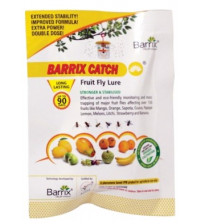
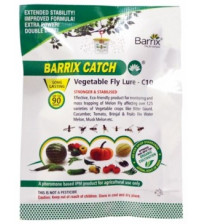
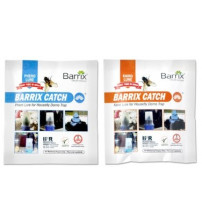
-202x224.png)
-202x224.png)
-202x224.png)
-202x224.png)
-202x224.png)
-202x224.png)
-202x224.png)
-202x224.png)
-202x224.png)
-202x224.png)
-202x224.png)
-202x224.png)
-202x224.png)
-202x224.png)
-202x224.png)
-202x224.png)
-202x224.png)
 Turning Point/Pheromone-trap-Diamond-Black-moth-DBM-Lure-Plutella-Xycostella-Funnel-trap-chipku-01-Copy(400)-202x224.png)
 Turning Point/1_Lucinodes-Orbonalis-Brinjal-fruit-and-shoot-borer-lucin(400)-202x224.png)
 Turning Point/1-Pheromone-trap-Yellow-stem-borer-Rice(400)-202x224.png)
 Turning Point/1-Brinjal-fruit-and-shoot-borer-lucin-lure-Funnel-trap-chipku-01(400)-202x224.png)
 Turning Point/Spodoptera-Litura-1(400)-202x224.png)
 Turning Point/Pink-bollworm-01(400)-202x224.png)
 Turning Point/helicoverpa-01(400)-202x224.png)
 Turning Point/Helicoverpa Armigera-202x224.png)
 Turning Point/Fruit-fly(400)-202x224.png)
 Turning Point/MelonFly (400)-202x224.png)
 Turning Point/Brinjal Fruit Shoot Borer(400)-202x224.png)
 Turning Point/Pectinophora gossypiella(400)-202x224.png)
 Turning Point/Spodoptera Litura(400)-202x224.png)
 Turning Point/DBM(400)-202x224.png)
 Turning Point/Yellow Stem Borer(400)-202x224.png)
 Turning Point/Fruit-fly-Mac-phill-01(400)-202x224.png)
 Turning Point/Melon-Fly-eco-trap(400)-202x224.png)
 Turning Point/Melon-Fly-Mac-Phill(400)-202x224.png)
 Turning Point/Chipku-yellow-sticky-trap(400)-202x224.png)
 Turning Point/yst-A4(400)-202x224.png)
 Turning Point/Blue Sticky Trap-01(400)-202x224.png)
 Turning Point/chipku-gum(400)-202x224.png)
 Turning Point/CHipku-Gummy-bag(400)-202x224.png)
 Turning Point/2021/yellow-sticky-trap (400)-202x224.jpg)
 Turning Point/2021/rat-trap-01 (400)-202x224.jpg)
 Turning Point/2021/solar-trap-3 (400)-202x224.jpg)
 Turning Point/2021/fruit-fly-liquid-01 (400)-202x224.png)
 Turning Point/2021/RB-Lure-2 (400)-202x224.jpg)
 Turning Point/2021/Amish A (400)-202x224.jpg)
 Turning Point/2021/Bucket-Trap-With-RPW-Lure (400)-202x224.jpg)
